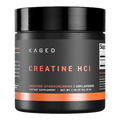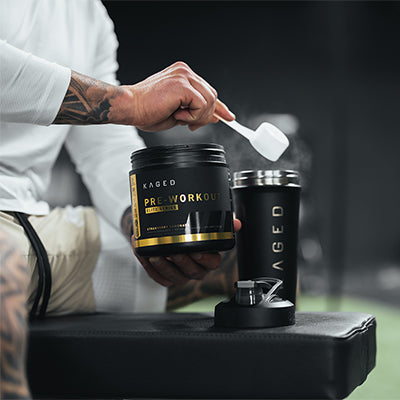What You Need to Know About Kris Gethin’s DTP Training Technique
The Dramatic Transformation Principle is a training system I devised after years of research, application, and analysis of its effectiveness. DTP, as it is better known, has played a fundamental role in transforming over 150 million lives, a statistic which thoroughly supports the undeniable impact of this training approach.
Even though the reach of DTP spans across the globe, many people still have questions about this training strategy. Every day on the Kaged social media pages, people request more information on DTP, which is what led me to write this article.
After reading this, you’ll have no uncertainties around the benefits of DTP training; furthermore, you’ll be able to apply it to your own training for maximum effects.
DTP Training Format
To help you understand exactly what a DTP workout looks like, the following example has been provided. Two quad exercises have been used to demonstrate the set and rep format.
Leg Press
- Set 1: 50 repetitions
- Set 2: 40 repetitions
- Set 3: 30 repetitions
- Set 4: 20 repetitions
- Set 5: 10 repetitions
Leg Extensions
- Set 1: 10 repetitions
- Set 2: 20 repetitions
- Set 3: 30 repetitions
- Set 4: 40 repetitions
- Set 5: 50 repetitions
Rest intervals will be shorter between the lighter, high rep sets as the slow twitch muscle fibers recover quickly. Approximately 60 seconds between these sets will suffice. For the heavier and lower rep sets, where fast twitch muscle fibers do the majority of work, taking up to 120 seconds is recommended to ensure you’re adequately rested for maximal performance. When following DTP, applying the correct amount of rest between sets ensures training tempo is maintained.
An application where DTP shines is when you have limited training equipment. If DTP is executed properly, you can annihilate a muscle group with very few exercises – anywhere between one to four should suffice. In the quad example provided, two exercises were used, but you can complete the entire pyramid with one exercise if necessary.
**There are other variations of DTP, such as DTPXtreme which employs a superset format. Both approaches will be discussed in this article to thoroughly demonstrate the application of these principles.**
Optimizing Muscle Fiber Activity
The most significant benefit of using DTP training is the way it engages every type of muscle fiber in the same workout. No other form of resistance training is as comprehensive. Leveraging the impact of high, moderate, and low repetition ranges means that every muscle fiber is stimulated. The advantage of this is accelerated sarcoplasmic and myofibrillar hypertrophy, both of which are essential for growth.
Melting Fat Quickly
As DTP’s unique training pyramid engages every type of muscle fiber, extreme amounts of energy are required, not only during but also after the workout is complete. During the workout, fuel is expended at an alarming rate to sustain performance and support recovery. However, after the workout is complete, the oxygen debt created is so dramatic that heightened energy expenditure continues for approximately 24 hours! Scientifically, this is known as excess post-exercise oxygen consumption, whereby the body must repay the oxygen debt incurred during training. All intense training can trigger this response, but due to the extreme nature of DTP, it can elevate this response to new levels. The outcome for you is accelerated fat loss, healthier blood sugar management, and improved insulin sensitivity.
Enhancing Health & Fitness Metrics
Looking good in the mirror isn’t enough - health should always remain the priority. DTP addresses and improves health through a variety of facets. Cardiovascular fitness quickly improves when using DTP regularly. Specifically, the heart becomes more efficient as it has to work hard to distribute oxygenated blood around the body. When the heart becomes more efficient at distributing blood, improved blood pressure is a common outcome.
Time Efficient Results
Having had the opportunity to work with millions of people as they transform their body and health, one of the biggest obstacles individuals face is a lack of time. This excuse is continually used to explain a lack of progress, which is why I made sure DTP would yield results in a very time efficient manner. It’s possible to get a DTP workout complete in just 40 minutes, which answers this common barrier.
Utilizing DTP Yourself
Any new workout program can be daunting if you’re unsure how to apply it correctly. For this reason, I’ve provided a sample week of DTP training for your reference. Additionally, I have included more tips on how to get the most from your DTP workouts, as well as common mistakes you must avoid maximizing your progress.
Workout One: Shoulders & Calves
Machine Shoulder Press
- Set 1: 50 repetitions
- Set 2: 40 repetitions
- Set 3: 30 repetitions
- Set 4: 20 repetitions
- Set 5: 10 repetitions
Cable Upright Rows
- Set 1: 10 repetitions
- Set 2: 20 repetitions
- Set 3: 30 repetitions
- Set 4: 40 repetitions
- Set 5: 50 repetitions
Standing Calf Raises
- Set 1: 50 repetitions
- Set 2: 40 repetitions
- Set 3: 30 repetitions
- Set 4: 20 repetitions
- Set 5: 10 repetitions
Seated Calf Raises
- Set 1: 10 repetitions
- Set 2: 20 repetitions
- Set 3: 30 repetitions
- Set 4: 40 repetitions
- Set 5: 50 repetitions
Workout Two: Legs
Hack Squats
- Set 1: 50 repetitions
- Set 2: 40 repetitions
- Set 3: 30 repetitions
- Set 4: 20 repetitions
- Set 5: 10 repetitions
Walking Lunges
- Set 1: 10 repetitions
- Set 2: 20 repetitions
- Set 3: 30 repetitions
- Set 4: 40 repetitions
- Set 5: 50 repetitions
Workout Three: Back
Seated Cable Rows
- Set 1: 35 repetitions
- Set 2: 30 repetitions
- Set 3: 25 repetitions
- Set 4: 20 repetitions
- Set 5: 15 repetitions
- Set 6: 10 repetitions
Narrow Grip Pulldowns
- Set 1: 10 repetitions
- Set 2: 15 repetitions
- Set 3: 20 repetitions
- Set 4: 25 repetitions
- Set 5: 30 repetitions
- Set 6: 35 repetitions
Workout Four: Chest
Incline Dumbbell Press
- Set 1: 35 repetitions
- Set 2: 30 repetitions
- Set 3: 25 repetitions
- Set 4: 20 repetitions
- Set 5: 15 repetitions
- Set 6: 10 repetitions
Incline Cable Flys
- Set 1: 10 repetitions
- Set 2: 15 repetitions
- Set 3: 20 repetitions
- Set 4: 25 repetitions
- Set 5: 30 repetitions
- Set 6: 35 repetitions
Workout Five: Arms
Superset: Barbell Curls & Skull Crushers
- Set 1: 50 repetitions / 50 repetitions
- Set 2: 40 repetitions / 40 repetitions
- Set 3: 30 repetitions / 30 repetitions
- Set 4: 20 repetitions / 20 repetitions
- Set 5: 10 repetitions / 10 repetitions
Superset: Seated Dumbbell Curls & Cable Pushdowns
- Set 1: 10 repetitions / 10 repetitions
- Set 2: 20 repetitions / 20 repetitions
- Set 3: 30 repetitions / 30 repetitions
- Set 4: 40 repetitions / 40 repetitions
- Set 5: 50 repetitions / 50 repetitions
It’s important to note two things from the above workouts. For the back and chest workouts, there are different rep schemes used. This format is DTPXtreme, a variant which has similar principles to the original DTP protocol. This is my favored approach for chest and back because it helps prevent fatigue at the shoulder joint and forearms, two weak points which can hinder progress when training these muscle groups.
Secondly, notice that supersets are used on the arm workouts. Supersetting exercises is the perfect way to add more intensity using DTP, especially when training antagonistic muscle groups together. Hopefully, by demonstrating these variations of the DTP training strategy, it shows how versatile these training philosophies can be, and how they can be applied to enhance your progress.
Do’s and Don’ts of DPT Training
The impact of DTP depends on your application, which is why I’m explicitly telling you how to employ it with precision. I want you to avoid making any mistakes which could sabotage your progress!
Do not be fooled into thinking 10 or 12 sets is easy. If done correctly, you will be begging for the pain to end. This all comes down to two factors, ensuring your rest periods are carefully monitored, and that the weight chosen is appropriate to the rep range being used. For example, on the 50 rep sets, you should be reaching failure by 25-30 repetitions, after which you should be fighting your way to the finish line using rest-pauses. If you reach 50 reps without stopping, the weight was far too light!
The burn within the muscle will surpass anything you have experienced before. This uncomfortable and painful feeling might lead you to think of short-cuts such as using sloppy form or even quitting early. Do not allow either to happen! It’s imperative that good exercise technique is maintained to yield the best results, and cutting out reps are only cheating your results. I suggest using PRE-KAGED before training and IN-KAGED during training.
Stay completely focused at all times, even during the rest intervals, to maintain peak performance. This training is so challenging that you cannot afford to be complacent, as such, it’s paramount to maintain mental engagement at all times. Keep your headphones on and avoid discussion between sets, otherwise, the intensity will quickly be lost.
Summary of DPT Training
Hopefully, this article clears up any questions you may have had regarding DTP and can serve as your DTP guide at all times. Employing this training approach will open the door to new levels of progress and physical growth. Using this training system for four weeks will help shatter any plateau you may have hit, and enable you to see results quickly.

























